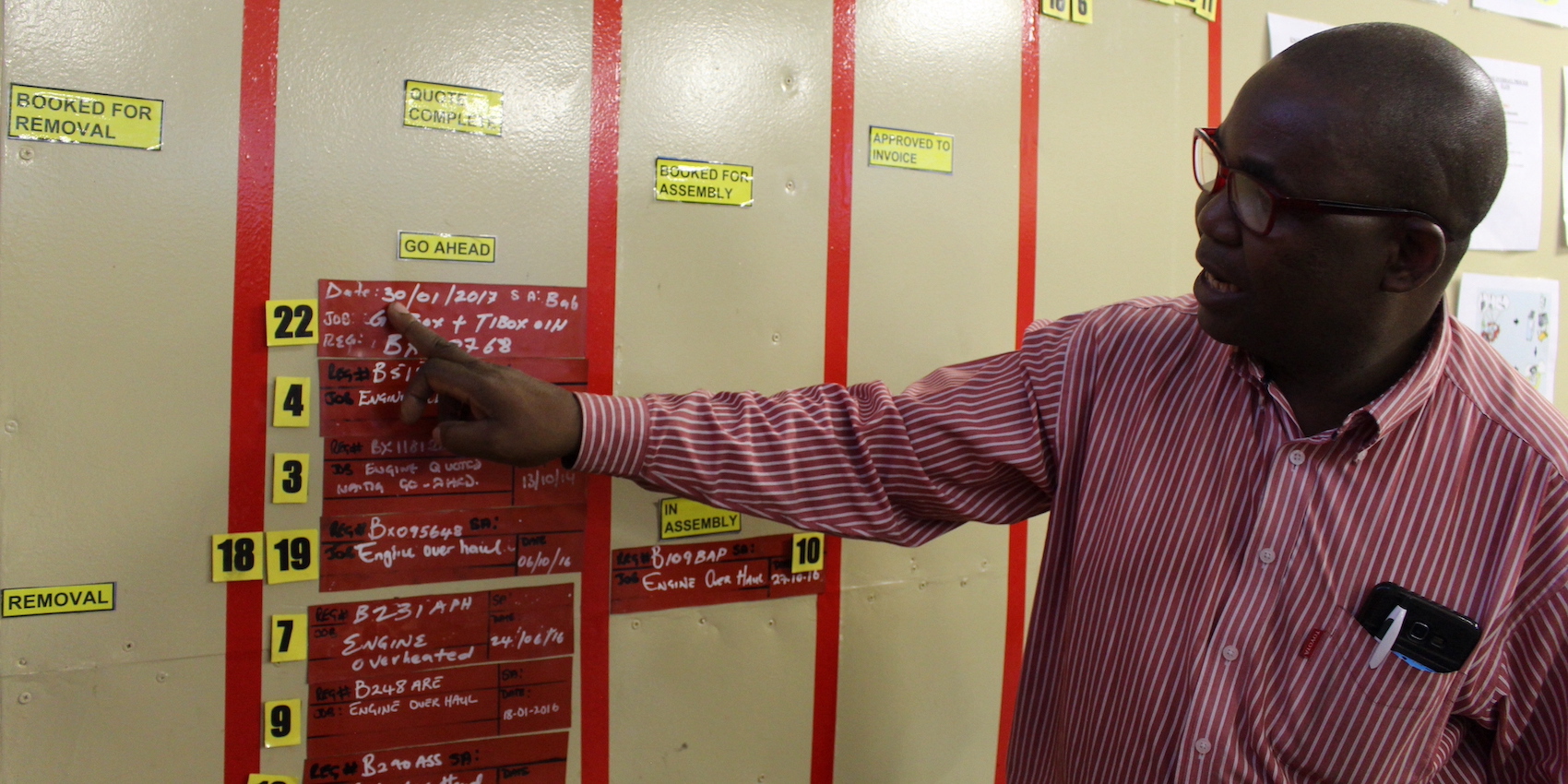
How to successfully roll out and sustain TWI programs
FEATURE – The use of TWI is widespread, but course material doesn’t tell us much about rolling out programs and ensuring their sustainment over time. The authors come to the rescue, discussing how we can ensure the success of TWI.
Words: Art Smalley, Patrick Graupp, and Scott Curtis
For many organizations around the world attempting improvement, Training Within Industry (TWI) courses supply ready-made programs for helping supervisors deal with problems related to training, handling people, and making small daily improvements.
Indeed, the intellectual robustness and universal applicability of the TWI material for Job Instructions (JI), Job Relations (JR), and Job Methods (JM) is well established. Demand for the courses is growing every year and success stories are commonly presented at various conferences. Companies using TWI report significant improvements in critical KPIs even after the initial Pilot Area training (for example, a turbine blades manufacturer recently reported a 90% reduction in process downtime due to failed quality tests). Despite the overall success rate, however, there are many (committed) organizations in all sectors that struggle to get things started with TWI. In particular, they find it difficult to scale up the training and sustain it in the long run.
Unfortunately, the TWI course materials don’t provide us with much advice on this topic. They were designed for in-class delivery with actual demonstration practice involving real situations, but they don't tell us how to roll out the programs or link them to existing systems of daily management to ensure long-term sustainment. Moreover, in the original days of TWI, trainers stayed with companies longer or made multiple follow-up visits to training sites: one can surmise that this problem was simply not as pronounced back then.
Partial aids to this modern-day problem of rollout, connection to daily management systems, and sustainment arguably do exist in lesser known TWI materials developed in the 1950s, such as Program Development and Problem Solving. While these materials were not as popular and never caught on with the same level of enthusiasm or success, they provide us with insights into how to better use TWI. Additionally, we’ve collectively been helping organizations face this challenge for some time and have developed certain insights regarding success. In this article, with a nod to good TWI practices, we’ll outline what we believe to be the important steps, key points, and reasons why for ensuring a proper roll out. (Of course, not every situation is the same, so blindly following these steps won’t guarantee success.)
PDCA CYCLE OF MANAGEMENT
Our first point involves the fundamental principle of Plan-Do-Check-Act (PDCA) and how you should think about any cycle of management including TWI content rollout. Consider the following framework as a macro-outline for all our steps in this article. Since the TWI JI course is the most widely attended and practiced, we’ll frame a sample roll out scenario in those terms.

Successful organizations build a plan like this up front for their TWI implementation efforts. Plans can be rough outlines in the beginning but they should be reviewed and refined as the learning progresses. The most common failure mode we observe is to plan simply for the basic 10-hour training of a TWI course, such as Job Instruction, and then send people back to their areas of work without a structured support mechanism like the one above. As the famous saying goes, “Failure to plan is the same as planning to fail”. Returning people to their previous system of work without a solid plan is not a foundation for long-term success. Completion of a basic training class alone won’t change the culture or existing processes in your organization. All the points in the table above are important and can be a cause for failure if neglected. For reasons of length in this article we’ll hone in on a few of the most important steps which, for the most part, occur after the initial TWI training is complete.
1. Top management alignment and preparation
A critical step that is often underestimated or overlooked is the importance of top management support for implementing TWI. Whether it is assuming TWI is just a “training” process that a staff member should work on or assuming this is a 12-week project that is finished after the 10-hour classes are completed, the results are the same and can be linked back to top management lack of preparation and understanding. Getting true top management buy-in is a critical step in the long-term success of TWI. A simple but effective series of steps can help guide an organization to getting management alignment.
Top management should: understand the role of TWI; tie TWI to key strategic objectives (Why are we doing this work?); select a strong TWI champion to drive change; designate a member to report progress to management; and openly support the TWI initiative, go to gemba and participate.
With top management support many of the normal obstacles encountered while doing the initial pilot work can be quickly eliminated.
2. Designation of a pilot area for implementation and learning
After the initial classroom training is complete you need an area to go to practice the newly-acquired skill and take things to the next level. Only so much can be demonstrated or learned in a classroom. Just like with physical sports or martial arts, you must leave the comfort of the meeting room and get on an actual practice field to improve. It is natural to have questions, doubts, or even face struggles when you begin implementation. The best way to meet this challenge is to designate a pilot area up front of manageable size to practice the TWI skills of JI, for example. We also need real-world feedback as we learn how to create job breakdown sheets, the training timetable, TWI JI training activities, and the all-important connection to real world daily problems.
Importantly, when selecting where to pilot the training, pick an area that is representative of your work with actual problems related to TWI contents. Don’t cherry pick the easiest place possible. The application and practice of JI starts in the Pilot area after the 10-hour training is completed – the objective being to increase skills and competency in JI and to establish and maintain new standards in the Pilot area. The long-term success of the roll out will depend on the very visible success of this pilot project, so select a location where people will think, “Wow, if it worked there like that then it will work just about everywhere!”
3. Establishment of KPIs to monitor performance
In addition to defining a pilot area, for learning purposes it is vital to also establish a clear set of goals and metrics to evaluate the impact of, for example, TWI Job Instruction training. Metrics taken during TWI’s initial use during WWII showed that, invirtually every instance of application, productivity improved, defects were reduced, safety was enhanced, and training time was reduced, etc. by more than 25%. Today these improvements are still being achieved and many are even more significant than experienced during that era. For example, training time to attain a higher skill level is regularly reduced by 50-75%. That means that if entry-level employees take on average four weeks to get to a level of proficiency, you can reduce this to one week with the proper application of JI. You need to have your set of metrics and goals in place to evaluate the effectiveness of the TWI program implementation. Training for the sake of training is not bad, but it should exist for a specific purpose. Be clear on what you are trying to impact and how it trends over time with the introduction of TWI skills to the area in question. Understanding how TWI helps improve performance is critical if you want this program to stick in the long run.
4. Creation of a cross training matrix and skills gap prioritization
The TWI JI training class introduces you to the concept of the TWI Training Timetable. The matrix is an excellent tool for visual control and seeing where we have skills gaps and training needs. Every situation we observe is somewhat different. Some organizations struggle with training of new employees, some struggle with creating enough skilled back-up operators, some face chronic quality or safety problems. The purpose of the Training Timetable is to help surface these issues and put focus on specific needs first. Think of the matrix as a combination “heat map” and “Pareto chart”. When properly created and analyzed the matrix should help point you where to go for maximum impact.
5. Creation of Job Instruction Breakdown Sheets (JIBs)
Our experience shows that after taking the Job Instruction 10-hour course, trainers still need additional coaching and practice in making good Job Breakdown Sheets. With the TWI “learn-by-doing” approach, participants bring in “small and simple” jobs for practice to the training, the purpose being to learn the instruction method and not to handle the most difficult job in the department. Once in the pilot, though, the real world of work complexity and size comes into full scope and this is where true application of the method begins to take place as JIBs for the pilot area jobs are developed. New JI instructors tend to make their job breakdowns too detailed or wordy and good coaching by the TWI trainers is needed to guide them to find the “few and simple” words that make an effective JIB. Keeping a good balance between important steps and key points also takes practice and experience. Even then, it is necessary to “road test” these breakdowns and continue to refine them as they get put into use.
6. Creation of a monthly training plan
Based on the Training Timetable developed earlier, a defined plan for training jobs in the pilot area must be put together and carried out. Depending on the scope, this plan can take many different shapes. It could be for a variety of different jobs on one production line, or one part of a production line, or focus on a few employees who work in a critical area. Or it could be for a single job trained to a multitude of people across several different departments. This was the case when, at a large hospital, they picked as their JI pilot, “How to wash your hands” for reducing the spread of germs or infections and associated problems. Nurses on multiple floors of the hospital were taught this single job by several trainers over several weeks’ time. This simple yet fundamental task was sufficient to reinforce the concept and drive home certain key points.

Copyright 2011 From :Implementing TWI: Creating and Managing a Skills Based Culture" by Patrick Graupp and Robert J. Wrona. Reproduced by permission of Taylor and Francis Group, LLC, a division of Informa plc.
7. Establish a problem-solving effort in conjunction with JI
One of the most critical things you can do to ensure long-term success with TWI programs such as JI is to roll them out and properly connect them to your organizational problem-solving routine. If you don’t have such a program, then we strongly urge you to create one in conjunction with TWI.
Think of this as “Push” versus “Pull”. The pull method is generally more effective and easier to maintain. Here’s an example: a company implements TWI JI training in an area because they know it is a good thing to do and they roll it out accordingly. Job Breakdown Sheets are created and some training conducted. Some positive results are noted but in the end the effort does not stick because people don’t see the point or need. This represents an example of “pushing” a solution that does not have a goal or a clear problem to solve.
Another company, however, realizes it has a set of specific quality problems that greatly affect process yield. Analysis of the problem shows that the yield varies widely both by shift and by operator. It becomes clear that certain operators were present during the installation of the equipment and learned specific practices and adjustment methods from the OEM. Unfortunately, those methods were held as tribal knowledge and were never documented or shared widely. Realizing this as a specific problem, the company created Job Breakdown Sheets for all aspects of the process based upon the best knowledge of the key people. In other words, they worked with the skilled operators to create the JIBs thus capturing their know-how. Proper TWI-style training was then conducted across the shifts for all personnel involved with the process. Process yields improved dramatically and everyone now performed at the same higher level. In this scenario the TWI training is far likelier to sustain moving forward because it proved its worth in helping solve a critical problem. The result is a natural organizational pull for more and not a hard sell or push to continue.
We cannot overstress how vital it is to connect your problem-solving process and thinking patterns to the TWI skills. This logical connection will help generate better results and make the overall process more likely to stick in the long run. The TWI founders realized this connection when they later made the TWI Problem Solving Training which incorporated the three traditional J programs (Job Instruction, Job Methods, and Job Relations) into a unified approach to resolving problems.
8. Creation (or modification) of the daily operational meeting
In conjunction with problem solving, another key element of sustainable TWI involves your daily operational meeting. Many companies have some form of a daily stand-up meeting at the start and end of shift where performance is quickly reviewed (if you don’t, we suggest you start one together with your TWI pilot area).
We suggest a basic pattern for the meetings:
- Daily Safety Minute
- General Announcements
- Operational Review (Output, Quality, Delivery, etc.)
- Red / Green Status (Green = Good, Red = Gap and next steps discussion)
- TWI Training Plan Related
- Assignments, Follow Up, and Next Steps
Start with a safety review of any recent incidents as needed but also consider a specific safety theme or message for the day in a proactive manner. Follow with any general announcements regarding operations in your area and key pieces of information that need to be shared with everyone.
Of course, your daily meeting for operational performance should also focus on results (plan versus actual) and incorporate your key metrics. If performance meets standard then we call that “green” and move on. If performance falls short of standard we call that “red” and make it visually apparent to everyone in attendance. For each “red” occurrence discuss the problem in a simple format, which should stir up some good TWI-related reflections.
For companies just starting with TWI we found that we often need to add a special section to the meeting where we reflect and review TWI concepts in connection to problem areas. Virtually every process or problem has a human element as part of the equation. Unfortunately, we continually find that some organizations fail to connect the logic of TWI and its underlying principles to the actual daily realities of running the operation. For this reason we recommend coaching and practicing TWI principles in conjunction with your daily operational meeting. Even if there is no pressing problem to discuss you should still review the training plan and the creation of Job Breakdown Sheets.
TO CONCLUDE
The key to sustaining programs is to get off on the right foot with a solid plan. If you create a plan emphasizing the activities discussed above along with problem solving and strong daily operational management we think you’ll have greater success and increase your odds of sustaining TWI programs in the long run.
This article is also available in Hungarian here.
THE AUTHORS



Read more


FEATURE – The Japanese organizing guru has become very popular in recent years, but what does Lean Thinking tell us about her approach?


INTERVIEW – Juan Pedro Gonzalez is a pioneer of lean in hospitality, having spearheaded the transformation of Spain’s Dreamplace hotels since the beginning. Here, he discusses what role lean can play in advancing the industry.


COLUMN - In the first installment of her new column, the CIO of Finnish defense company Patria shares her thoughts on what makes lean management so critical in the life of the leader of an IT department.


FEATURE – Sharon Visser shares her leader’s standard work from when she ran the Ngami car dealership and encourages us to use what we see at gemba to shape our own.

